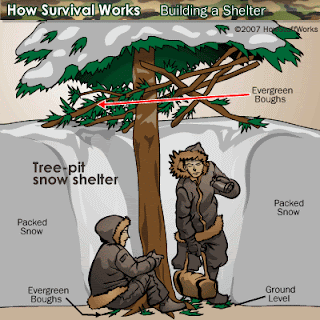
Short of making fire, the most important survival skill you will ever learn is to make a shelter from the elements. Though you may have time to find permanent natural shelters on many terrains, in two specific types of terrain you might not live long enough to complete your search. In a desert the longer that you're out in the sun, the quicker your body will overheat and lose moisture. In heavy snow conditions the longer that you're out in the open the faster the winds will leach the warmth from your body and kill you from hypothermia. For that reason this guide will explain how to make simple shelters in heavy snow or snowstorm conditions as well as in desert conditions.
Things You’ll Need:
Digging Tool
Things You’ll Need:
Digging Tool
Poncho or Sheet
Cutting Tool
Building A Snow Tree Shelter
Step 1:
Look for a good sized evergreen tree with decent branch coverage.
Step 2:
Dig the snow out around the tree until you've got to an appropriate depth or you hit ground. Create a pit surrounding the tree at least five feet in diameter.
Step 3:
Pack the snow you've dug up into the surrounding pit walls to avoid cave-ins. If possible, mound the snow up to increase the height of the wind break. The key to survival in snowy conditions is to get away from the wind. Though the snow may be at freezing level, the wind-chill factor is much lower than that and will quickly chill you to the bone. Once you're chilled there's really no way to get back the warmth you've lost.
Step 4:
Cut branches from the evergreen that hang as high as you can reach and drape them over the top of the pit to create a loose roof. Leave the low hanging branches on the tree, they form a natural windbreak and act as partial protection from the snow.
Step 5:
Huddle in the center of the pit and wait for the snow to let up enough for you to be able to find your way to more permanent shelter and safety. It may seem tempting, but do not under any circumstances allow yourself to fall asleep in the cold. When you sleep your body temperature, respiration, and heart rate all decreases. If that happens in below freezing conditions there is a good chance you will die in your sleep.
Building Shelter In Desert Conditions.
Step 1:
Look for a nearby outcropping of rocks, a valley between sand dunes, or a depression in the earth which you can take advantage of. The depression need not be too deep, but it should be a little longer than your body and about a foot wider than your shoulders.
Step 2:
Use your digging tool to deepen the depression you've found. The trench you dig should be at least two feet deep and a little longer than your body. It need not be of uniform depth. The area where your torso and upper body should be as deep as possible to insulate from the heat of the sun, but your legs and feet do not need so much protection, so the trench can angle upward. This will save some time and effort.
Step 3:
Drape your poncho, clothes, or sheets over the top of the trench, leaving room near where your feet will go to crawl in and out. Stretch it as taught as possible to keep it from touching you when you are in your shelter. Anchor the poncho down on three sides of the trench with any nearby rocks. Sand will work too if no rocks are close by.
Step 4:
Sprinkle a loose layer of sand over the top of the poncho to add further insulation. Try to cover the poncho entirely without collapsing it. On the one hand the more sand you pile on the better it is at preventing heat energy from the sun getting to you, on the other hand the increased weight makes the covering more likely to collapse.
Step 5:
Crawl into your shelter and try to rest. During the daylight hours this shelter can reduce the surrounding temperature by as much as 40 degrees Fahrenheit. When night falls get out of your shelter, take your tools and poncho with you, and try to find help, water, or more permanent shelter.
Tips & Warnings
It should be noted that these shelters are not made for comfort; they are a quick way to get out of hostile elements to aid in your survival.

No comments:
Post a Comment